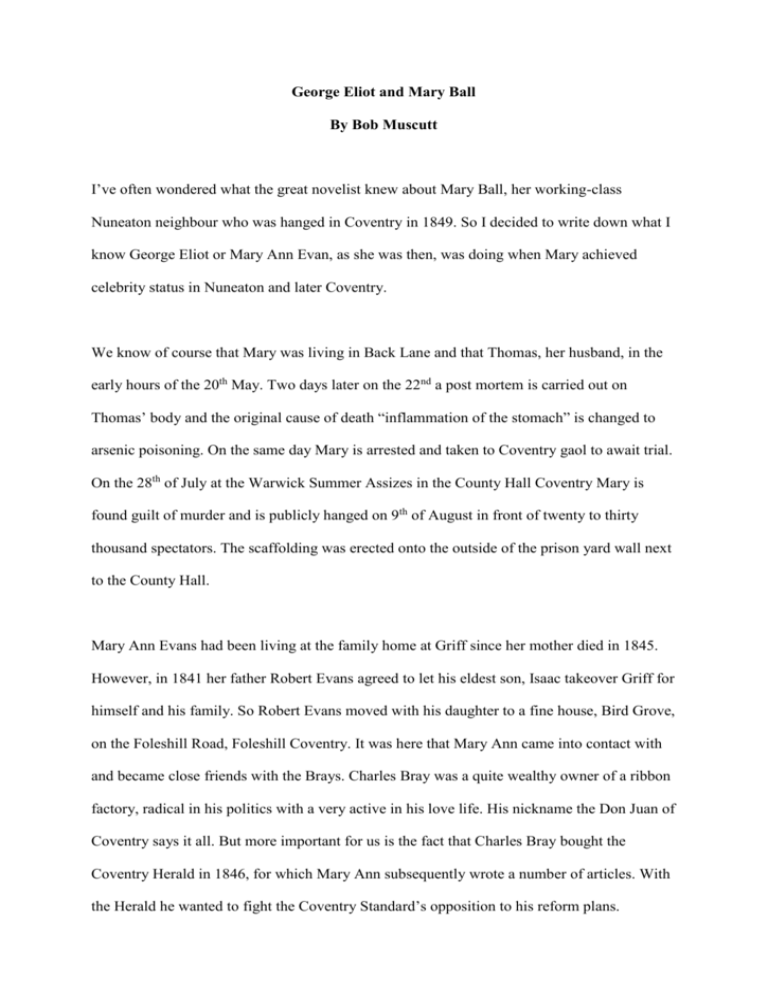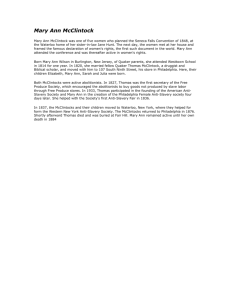George Eliot and Mary Ball - Nuneaton and Bedworth History
advertisement

George Eliot and Mary Ball By Bob Muscutt I’ve often wondered what the great novelist knew about Mary Ball, her working-class Nuneaton neighbour who was hanged in Coventry in 1849. So I decided to write down what I know George Eliot or Mary Ann Evan, as she was then, was doing when Mary achieved celebrity status in Nuneaton and later Coventry. We know of course that Mary was living in Back Lane and that Thomas, her husband, in the early hours of the 20th May. Two days later on the 22nd a post mortem is carried out on Thomas’ body and the original cause of death “inflammation of the stomach” is changed to arsenic poisoning. On the same day Mary is arrested and taken to Coventry gaol to await trial. On the 28th of July at the Warwick Summer Assizes in the County Hall Coventry Mary is found guilt of murder and is publicly hanged on 9th of August in front of twenty to thirty thousand spectators. The scaffolding was erected onto the outside of the prison yard wall next to the County Hall. Mary Ann Evans had been living at the family home at Griff since her mother died in 1845. However, in 1841 her father Robert Evans agreed to let his eldest son, Isaac takeover Griff for himself and his family. So Robert Evans moved with his daughter to a fine house, Bird Grove, on the Foleshill Road, Foleshill Coventry. It was here that Mary Ann came into contact with and became close friends with the Brays. Charles Bray was a quite wealthy owner of a ribbon factory, radical in his politics with a very active in his love life. His nickname the Don Juan of Coventry says it all. But more important for us is the fact that Charles Bray bought the Coventry Herald in 1846, for which Mary Ann subsequently wrote a number of articles. With the Herald he wanted to fight the Coventry Standard’s opposition to his reform plans. So in the second half of the 1840s we have Mary Ann, intellectually brilliant and a fearless pursuer of truth, living close to and often visiting one of the politically most radical and religiously free-thinking circle of friends in Coventry. And the lion of the group owns a major local newspaper. In May 1849 Robert Evans was very ill and Mary Ann, despite their fundamental differences of opinion in politics and religion, nursed him attentively. From early May her few letters are concerned almost exclusively with reports of her father’s health. On the 31 May he died and was buried at Chilvers Coton Church on 6th June. Less than a week later, on the 12th June, Mary Ann left England with the Brays, Charles and Cara, for a long tour of the Continent. So what are the chances that Mary Ann would have known anything about the murder case that was the talk of her native town, Nuneaton? As far as I know she never mentioned Mary Ball in those of her letters or in her journals which survived her later husband’s, John Cross’ censorship. But at least two reports of the case had appeared in the Coventry Herald in late May, one reporting the post mortem and the other Mary’s arrest. Is it likely that Mary Ann would have missed these short but drama-packed articles? I don’t think so, especially as they appeared in the newspaper owned by her closest friends and for which she herself wrote articles. Of course Mary made news even before the trial started when, on 24th July, she was tortured by the prison chaplain, Chapman. This became widely known in Coventry. A handbill gave details of the incident and of the disciplinary action imposed on Chapman. There was even a typically satirical report of the incident in the London Punch magazine. Mary Ann Evans was sill touring Europe at this time, only returning to England in March 1850. It was while she was in Geneva that she began to keep her Journal, a detailed account of her everyday life and thoughts. Unfortunately, her widower, John Cross, cut out and destroyed the fist 46 pages of this intimate record of her life from 1849 – 1854 while he was preparing his much edited and censored Life of George Eliot after her death in1880. In a long letter written from Geneva to Mr and Mrs Charles Bray and Sara Hennell, Cara’s sister, on 20th August Mary Ann complains of being starved of books to read and thanks her friends “for the trouble you have taken about my luggage.” In the next sentence she writes: "I shall be particularly glad of the newspaper for I never see anything here except daily French papers …” The newspaper she refers to is of course the Coventry Herald. In a letter written in reply to the Brays on the 28th August she points out that her boxes of luggage have still not arrived. She is obviously longing to receive them and has been told “it takes a month to get things from England.” Later in the same letter she writes: “I am very much amused with the Coventry gossip – pray tell me as much of it as you can. … I have received no papers yet and I do not know whether any have been despatched. I assure you the four columns of the Coventry Herald would be as interesting to me as a love-letter.” These few letters that have survived reveal Mary Ann’s undisguised and intense desire to be kept up to date on life in Coventry in July - August 1849. And of course two events that gripped the city’s attention were Mary’s trial in the County Hall on 28th July and the execution on 9th August. Between these two dramatic days were the torture incident and also the publication of Mary’s co-called confession which she made on 5th August to Mr Stanley, prison governor. I have no hard evidence but it seems unlikely to me that none of Mary Ann’s acquaintances would have informed her about these sensational news items, especially, as already noted, she was ravenous for news from home and her closest friends owned Coventry’s leading source of local news. As we know, Mary Ann remained on the continent until well into 1850, but what about her companions, the Brays? As the correspondence between them and Mary Ann shows, they were back home in Foleshill. They had left Switzerland on 25th or 26th July. Cara Bray’s Commonplace Book has an entry for 3rd August: “Home!” This means that, assuming Charles and Cara travelled together; they would have missed the trial but would have been back in time for the execution. One other point seems worth mentioning here. As we know, Charles Bray was a life-long supporter of phrenology with a vast collection of plaster casts of famous and infamous people’s heads. He even persuaded young Mary Ann Evans to shave her head and have a cast made! As we know, the so-called death mask of Mary Ball still exists and can be viewed in the Coventry Police Museum. I wonder if Charles Bray had anything to do with this cast of Mary’s face being made. This would belong more to physiognomy than phrenology but he was also interested in that “science”. And please allow me one final speculation. The Coventry Herald reported the trial in great detail. The report can be obtained from Coventry Library. If Mary Ann did in fact read this gripping piece of journalism. Did it have any influence on her writing? The trial of Hetty Sorrel in Adam Bede, for example?







